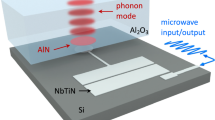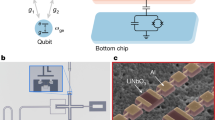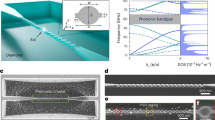Abstract
Approaches to quantum computing that use itinerant photons are appealing because they have relatively few physical requirements. However, at present, many elements of photonic quantum computers are nondeterministic, presenting a challenge for large-scale devices. One alternative is to use similar schemes with itinerant phonons in solid-state devices, rather than photons, combined with superconducting transmon devices. Here we present an advancement in the ability to deterministically manipulate and measure acoustic phonon quantum states. First, we demonstrate the deterministic phase control of itinerant one- and two-phonon qubit states, which we measure using an acoustic Mach–Zehnder interferometer. We implement phonon phase control using the frequency-dependent scattering of phonon states from a superconducting transmon qubit. Additionally, we propose and implement a multiphonon detection scheme that enables coherent conversion between itinerant one- and two-phonon Fock states and transmon qutrit states, for example, transforming an entangled two-phonon output state into the entangled state of two transmons. The integration of quantum acoustics with superconducting circuits in our implementation promises further advances, including deterministic phonon quantum gates with direct applications to quantum computing.
This is a preview of subscription content, access via your institution
Access options
Access Nature and 54 other Nature Portfolio journals
Get Nature+, our best-value online-access subscription
$32.99 / 30 days
cancel any time
Subscribe to this journal
Receive 12 print issues and online access
$259.00 per year
only $21.58 per issue
Buy this article
- Purchase on SpringerLink
- Instant access to full article PDF
Prices may be subject to local taxes which are calculated during checkout




Similar content being viewed by others
Data availability
Source data for figures in the main text are available via figshare at https://doi.org/10.6084/m9.figshare.28589732. All other data related to this study are available from the corresponding author upon request.
References
Knill, E., Laflamme, R. & Milburn, G. J. A scheme for efficient quantum computation with linear optics. Nature 409, 46–52 (2001).
Kok, P. et al. Linear optical quantum computing with photonic qubits. Rev. Mod. Phys. 79, 135–174 (2007).
Maring, N. et al. A versatile single-photon-based quantum computing platform. Nat. Photon. 18, 603–609 (2024).
Bogaerts, W. et al. Programmable photonic circuits. Nature 586, 207–216 (2020).
Zhong, H.-S. et al. Quantum computational advantage using photons. Science 370, 1460–1463 (2020).
Madsen, L. S. et al. Quantum computational advantage with a programmable photonic processor. Nature 606, 75–81 (2022).
Aghaee Rad, H. et al. Scaling and networking a modular photonic quantum computer. Nature 638, 912–919 (2025).
Alexander, K. et al. A manufacturable platform for photonic quantum computing. Nature 641, 876–883 (2025).
O’Connell, A. D. et al. Quantum ground state and single-phonon control of a mechanical resonator. Nature 464, 697–703 (2010).
Chan, J. et al. Laser cooling of a nanomechanical oscillator into its quantum ground state. Nature 478, 89–92 (2011).
Chu, Y. et al. Quantum acoustics with superconducting qubits. Science 358, 199–202 (2017).
Satzinger, K. J. et al. Quantum control of surface acoustic-wave phonons. Nature 563, 661–665 (2018).
Qiao, H. et al. Splitting phonons: building a platform for linear mechanical quantum computing. Science 380, 1030–1033 (2023).
Arrangoiz-Arriola, P. et al. Resolving the energy levels of a nanomechanical oscillator. Nature 571, 537–540 (2019).
Fu, W. et al. Phononic integrated circuitry and spin–orbit interaction of phonons. Nat. Commun. 10, 2743 (2019).
Kuzyk, M. C. & Wang, H. Scaling phononic quantum networks of solid-state spins with closed mechanical subsystems. Phys. Rev. X 8, 041027 (2018).
Taylor, J. C., Chatterjee, E., Kindel, W. F., Soh, D. & Eichenfield, M. Reconfigurable quantum phononic circuits via piezo-acoustomechanical interactions. npj Quantum Inf. 8, 19 (2022).
Chu, Y. et al. Creation and control of multi-phonon Fock states in a bulk acoustic-wave resonator. Nature 563, 666–670 (2018).
MacCabe, G. S. et al. Nano-acoustic resonator with ultralong phonon lifetime. Science 370, 840–843 (2020).
Zivari, A., Stockill, R., Fiaschi, N. & Gröblacher, S. Non-classical mechanical states guided in a phononic waveguide. Nat. Phys. 18, 789–793 (2022).
Bozkurt, A. et al. A quantum electromechanical interface for long-lived phonons. Nat. Phys. 19, 1326–1332 (2023).
Bozkurt, A. B., Golami, O., Yu, Y., Tian, H. & Mirhosseini, M. A mechanical quantum memory for microwave photons. Nat. Phys. https://doi.org/10.1038/s41567-025-02975-w (2025).
Hitchcock, O. A. et al. Correlated dephasing in a piezoelectrically transduced silicon phononic waveguide. Preprint at https://arxiv.org/abs/2502.16426 (2025).
Bochmann, J., Vainsencher, A., Awschalom, D. D. & Cleland, A. N. Nanomechanical coupling between microwave and optical photons. Nat. Phys. 9, 712–716 (2013).
Andrews, R. W. et al. Bidirectional and efficient conversion between microwave and optical light. Nat. Phys. 10, 321–326 (2014).
Mirhosseini, M., Sipahigil, A., Kalaee, M. & Painter, O. Superconducting qubit to optical photon transduction. Nature 588, 599–603 (2020).
Jiang, W. et al. Efficient bidirectional piezo-optomechanical transduction between microwave and optical frequency. Nat. Commun. 11, 1166 (2020).
Arnold, G. et al. Converting microwave and telecom photons with a silicon photonic nanomechanical interface. Nat. Commun. 11, 4460 (2020).
Weaver, M. J. et al. An integrated microwave-to-optics interface for scalable quantum computing. Nat. Nanotechnol. 19, 166–172 (2023).
Hann, C. T. et al. Hardware-efficient quantum random access memory with hybrid quantum acoustic systems. Phys. Rev. Lett. 123, 250501 (2019).
Wallucks, A., Marinković, I., Hensen, B., Stockill, R. & Gröblacher, S. A quantum memory at telecom wavelengths. Nat. Phys. 16, 772–777 (2020).
Chamberland, C. et al. Building a fault-tolerant quantum computer using concatenated cat codes. PRX Quantum 3, 010329 (2022).
Wollack, E. A. et al. Quantum state preparation and tomography of entangled mechanical resonators. Nature 604, 463–467 (2022).
Chou, M.-H. et al. Deterministic multi-phonon entanglement between two mechanical resonators on separate substrates. Nat. Commun. 16, 1450 (2025).
Gustafsson, M. V. et al. Propagating phonons coupled to an artificial atom. Science 346, 207–211 (2014).
Bienfait, A. et al. Phonon-mediated quantum state transfer and remote qubit entanglement. Science 364, 368–371 (2019).
Dumur, É. et al. Quantum communication with itinerant surface acoustic wave phonons. npj Quantum Inf. 7, 173 (2021).
Van Campenhout, J., Green, W. M. J., Assefa, S. & Vlasov, Y. A. Integrated NiSi waveguide heaters for cmos-compatible silicon thermo-optic devices. Opt. Lett. 35, 1013–1015 (2010).
Englund, D. et al. Controlling cavity reflectivity with a single quantum dot. Nature 450, 857–861 (2007).
Tiecke, T. G. et al. Nanophotonic quantum phase switch with a single atom. Nature 508, 241–244 (2014).
Bhaskar, M. K. et al. Experimental demonstration of memory-enhanced quantum communication. Nature 580, 60–64 (2020).
Kono, S., Koshino, K., Tabuchi, Y., Noguchi, A. & Nakamura, Y. Quantum non-demolition detection of an itinerant microwave photon. Nat. Phys. 14, 546–549 (2018).
Besse, J.-C. et al. Single-shot quantum nondemolition detection of individual itinerant microwave photons. Phys. Rev. X 8, 021003 (2018).
Zhang, J. et al. Broadband tunable phase shifter for microwaves. AIP Adv. 10, 065128 (2020).
Koch, J. et al. Charge-insensitive qubit design derived from the Cooper pair box. Phys. Rev. A 76, 042319 (2007).
Barends, R. et al. Coherent Josephson qubit suitable for scalable quantum integrated circuits. Phys. Rev. Lett. 111, 080502 (2013).
Chen, Y. et al. Qubit architecture with high coherence and fast tunable coupling. Phys. Rev. Lett. 113, 220502 (2014).
Ekström, M. K. et al. Surface acoustic wave unidirectional transducers for quantum applications. Appl. Phys. Lett. 110, 073105 (2017).
Lund, M. M., Yang, F. & Mølmer, K. Perfect splitting of a two-photon pulse. Phys. Rev. A 107, 023715 (2023).
Beaudoin, F., da Silva, M. P., Dutton, Z. & Blais, A. First-order sidebands in circuit QED using qubit frequency modulation. Phys. Rev. A 86, 022305 (2012).
Besse, J.-C. et al. Realizing a deterministic source of multipartite-entangled photonic qubits. Nat. Commun. 11, 4877 (2020).
Ferreira, V. S., Kim, G., Butler, A., Pichler, H. & Painter, O. Deterministic generation of multidimensional photonic cluster states with a single quantum emitter. Nat. Phys. 20, 865–870 (2024).
Wang, Z., Qiao, H., Cleland, A. N. & Jiang, L. Quantum random access memory with transmon-controlled phonon routing. Phys. Rev. Lett. 134, 210601 (2025).
Lemonde, M.-A. et al. Phonon networks with silicon-vacancy centers in diamond waveguides. Phys. Rev. Lett. 120, 213603 (2018).
Safavi-Naeini, A. H., Van Thourhout, D., Baets, R. & Van Laer, R. Controlling phonons and photons at the wavelength scale: integrated photonics meets integrated phononics. Optica 6, 213–232 (2019).
Neuman, T. et al. A phononic interface between a superconducting quantum processor and quantum networked spin memories. npj Quantum Inf. 7, 121 (2021).
Chen, W. et al. Scalable and programmable phononic network with trapped ions. Nat. Phys. 19, 877–883 (2023).
Steffen, M. et al. Measurement of the entanglement of two superconducting qubits via state tomography. Science 313, 1423–1425 (2006).
Bialczak, R. C. et al. Quantum process tomography of a universal entangling gate implemented with Josephson phase qubits. Nat. Phys. 6, 409–413 (2010).
Acknowledgements
This work was supported by the Defense Advanced Research Projects Agency (DARPA) under agreement number HR0011-24-9-0364 (A.N.C.), the Air Force Office of Scientific Research (AFOSR grant number FA9550-20-1-0270 (A.N.C.) and AFOSR MURI FA9550-23-1-0338 (A.N.C. and L.J.)), UChicago’s MRSEC (NSF award number DMR-2011854 (A.N.C.)), the NSF QLCI for HQAN (NSF award number 2016136 (A.N.C. and L.J.)), the Simons Foundation (Simons award number 5099 (A.N.C.)) and a 2024 Department of Defense Vannevar Bush Faculty Fellowship (ONR N000142512032 (A.N.C.)). This material is based on work supported by the US Department of Energy, Office of Science, National Quantum Information Science Research Center Q-NEXT (A.N.C. and L.J.) and was partially supported by UChicago’s MRSEC (NSF award number DMR-2011854 (A.N.C.)). We made use of the Pritzker Nanofabrication Facility, which receives support from SHyNE, a node of the National Science Foundation’s National Nanotechnology Coordinated Infrastructure (NSF grant number NNCI ECCS-2025633 (A.N.C.)).
Author information
Authors and Affiliations
Contributions
H.Q. designed and fabricated the devices, performed the measurements and analysed the data. Z.W. developed the theoretical protocol for two-phonon catch. A.N.C. advised on all efforts. H.Q., Z.W., G.A., A.A., C.R.C., Y.J.J., S.L., J.M.M., X.W., H.Y., L.J. and A.N.C. contributed to the discussions and production of the paper.
Corresponding author
Ethics declarations
Competing interests
The authors declare no competing interests.
Peer review
Peer review information
Nature Physics thanks the anonymous reviewers for their contribution to the peer review of this work.
Additional information
Publisher’s note Springer Nature remains neutral with regard to jurisdictional claims in published maps and institutional affiliations.
Extended data
Extended Data Fig. 1 Characterization of the scattering qubit Q2 acoustic emission spectrum.
a, Qubit Q2’s emission spectrum, measured by exciting the qubit and monitoring its subsequent excited state population Pe (color scale) as a function of time (vertical scale) as the qubit frequency is tuned across the UDT bandwidth (horizontal scale). The beamsplitter reflection yields features at ~ 550 ns, visible within the transducer unidirectional band from 3.91 GHz to 4.05 GHz. White dashed line indicates the qubit operating frequency of 3.925 GHz. Red dashed lines show the qubit ± χ = ± 189 MHz sideband frequencies when modulating the qubit at that frequency. b, Tunable qubit-UDT excited state population (color scale) as a function of time (vertical scale) and coupler G2 control pulse amplitude (arbitrary units; horizontal scale), for the initially excited-state qubit set to the operating frequency of 3.925 GHz. Green dots are fit T1 times as a function of G2 pulse amplitude. White arrow indicates coupling strength used in panel a, and used for single-phonon release from Q2. Black arrow indicates maximum coupling strength used in the phonon scattering experiments.
Extended Data Fig. 2 Noise floor of HOM experiment.
a, Data shown in Fig. 1b in log scale, here without visibility correction (see Methods). For the single-phonon splitting experiment, we expect at most one excitation during the entire process. The ideal Pee is zero for the duration of the experiments, and in particular, it should be zero after 650 ns, when each qubit has completed its capture of the split single-phonon wavepacket. We attribute the non-zero Pee population after that time to residual qubit thermal excitations and readout errors. We display the mean Pee population Pee,floor = 0.0014 ± 0.0005 from 650 to 800 ns (dashed gray line, with uncertainty represented by the shaded area). We note the cryostat base temperature is 7 mK, but Q2 starts with a spurious (thermal-like) population of around 0.4%, which we can convert to an effective temperature of 35 mK. When interacting with the phonon channel, Q2 gradually cools to an excited state population of 0.2% or an equivalent temperature of about 31 mK. As Q2’s excitation after catching the half-phonon wavepacket is 32%, this spurious population contributes roughly ~ 0.002 × 0.32 = 6.4 × 10−4 to the Pee background. A similar estimate for Q1 gives a total background of ~ 1.3 × 10−3 to Pee, which is close to our measured background of 0.0014 ± 0.0005. b, Data shown in Fig. 1d together with PQ1 and PQ2 in log scale, again here without visibility correction. The two-phonon interference experiments use a pulse sequence similar to that for the single-phonon experiments, and the final populations for PQ1 and PQ2 are close to those for the single-phonon experiments13. We observe Pee is suppressed near τ = 0, and at τ = 0 it is consistent with the baseline noise floor Pee,floor. We thus believe Pee,floor is a reasonable estimate for the noise floor in this experiment.
Extended Data Fig. 3 Time domain single-phonon phase gate.
a, b, As a supplement to Fig. 2a,b, when a single phonon is released by Q1 and scattered by Q2, the final output of the beamsplitter is routed towards Q1 or Q2, depending on the phase introduced by scattering from Q2. Inset in panel a shows the schematic of the experiment.
Extended Data Fig. 4 Uncorrected single phonon phase gate data.
a, b, Data from Fig. 2c,d plotted here in log scale, without a visibility correction. The average visibility for the Mach-Zehnder interferometry (not to be confused with the measurement visibility matrix) is \({{\mathcal{V}}}_{{\rm{MZ,raw}}}\equiv ({P}_{\max }-{P}_{\min })/({P}_{\max }+{P}_{\min })\)\(=0.979\pm 0.006\). We also measured the excited state population for each qubit after releasing a single phonon and being cooled by the acoustic channel, shown by the corresponding colored dashed lines, with the color-shaded regions representing one standard deviation in uncertainty. The noise floor limits the maximum measurable visibility to \(({P}_{\max }-{P}_{{\rm{floor}}})/({P}_{\max }+{P}_{{\rm{floor}}})=0.986\pm 0.001\).
Extended Data Fig. 5 Two-phonon phase gate measurements.
a, Two-qubit joint excitation probability Pee as a function of Q2 scattering detuning, as shown in Fig. 3d, and here including the single-phonon phase gate data shown in Fig. 2c, in log scale without visibility matrix correction. The two maxima in \({P}_{ee,\max }\) align in Q2 frequency with the single qubit excitation minima \({P}_{Q1,\min }\) and \({P}_{Q2,\min }\) (blue and orange dashed line), indicating the two-phonon phase shift is approximately twice that of the single-phonon phase shift. b, For fixed Q2 detuning at -9.2 MHz (red dashed line in panel a), the two-qubit joint excitation Pee is shown as a function of the coupler G2 control pulse amplitude. The minimum \({P}_{ee,\min }\) is reached for a pulse amplitude of -0.5 (a.u.), corresponding to maximum coupling. The coupler is turned off when the pulse amplitude is near zero, with no phase shift applied, where Pee approaches its maximum. The average visibility \({{\mathcal{V}}}_{{\rm{ee,raw}}}\equiv ({P}_{ee,\max }-{P}_{ee,\min })/{P}_{ee,\max }=0.968\pm 0.004\).
Extended Data Fig. 6 Theoretical phonon scattering process.
a, Theoretical scattering phase \(\arg \left\langle u \vert v\right\rangle\) (blue line; right vertical axis) as a function of detuning frequency, together with single-phonon phase gate data shown in Fig. 2c (orange and aqua points; left vertical axis). The theoretical scattering phases at \(\arg \left\langle u \vert v\right\rangle =\pi /2\) and 3π/2 align in detuning frequency with the two experimental single-phonon excitation minima, corresponding to a net π phase difference. b, Theoretical pulse distortion \(1-\left\vert \left\langle u \vert v\right\rangle \right\vert\) as a function of detuning frequency. The largest pulse distortion, 3 × 10−2, occurs at zero detuning. For a defined π-phase phonon gate implemented at detunings where \(\arg \left\langle u \vert v\right\rangle =\pi /2\) and 3π/2, the calculated pulse distortion leads to a scattering-induced phase gate infidelity of 8 × 10−3, as indicated by the horizontal dashed line.
Extended Data Fig. 7 Control experiment with and without qubit modulation.
Each panel shows the measured qutrit population with time for two different catch protocols. Inset pulse sequences illustrate the differences between the two experiments. a, a single phonon is released from Q1 and partially reflected by the BS. During the subsequent catch process, we use the qubit modulation pulse sequence shown in Fig. 4c. b, Catch process using the time-reversed control for the release process. Both experiments yield similar catch efficiencies (0.32 vs. 0.34). We observe no spurious phonon excitation to the transmon \(\left\vert\;f\;\right\rangle\) state, with or without qubit modulation.
Rights and permissions
Springer Nature or its licensor (e.g. a society or other partner) holds exclusive rights to this article under a publishing agreement with the author(s) or other rightsholder(s); author self-archiving of the accepted manuscript version of this article is solely governed by the terms of such publishing agreement and applicable law.
About this article
Cite this article
Qiao, H., Wang, Z., Andersson, G. et al. Acoustic phonon phase gates with number-resolving phonon detection. Nat. Phys. (2025). https://doi.org/10.1038/s41567-025-03027-z
Received:
Accepted:
Published:
DOI: https://doi.org/10.1038/s41567-025-03027-z



